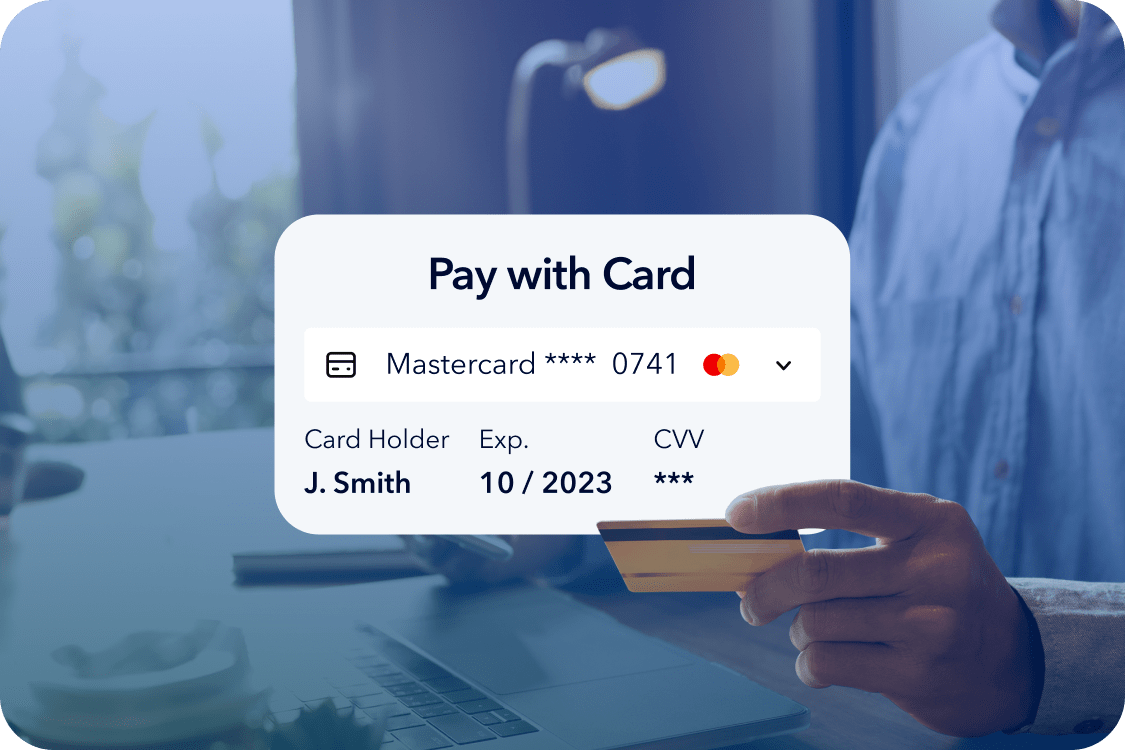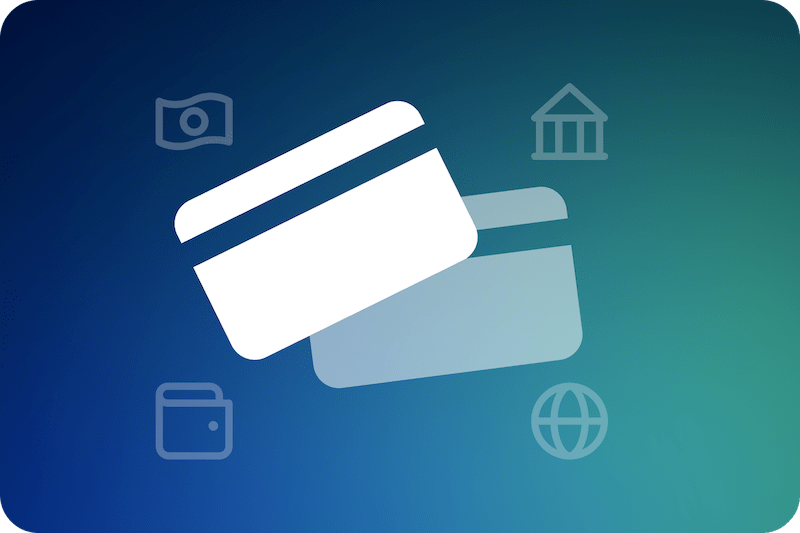ACH vs EFT payments 101: Similarities And differences
Here’s what you need to know about the 2 major payment methods, including how they compare and when to use them.

Noncash payments like check, credit card, and ACH payments are on the rise, to a value of $128 trillion per year. And as more consumers get comfortable with electronic payment methods, we can expect that number to continue increasing, for both B2C and B2B payments.
But the growing number of payment options can make it hard to keep track of which is which, and which payment method is right for each transaction.
Here’s what you need to know about two electronic payment methods — ACH vs. EFT payments — including how they compare and when to use them.
What is EFT?
An EFT, or electronic funds transfer, is a way to send money between bank accounts without the need for human intervention or physical paperwork. Historically, financial institutions had to process transfers manually, with paper checks and other analog methods used to verify and facilitate transactions.
EFT transfers use a computerized system to process payments automatically, so they take less time and are less prone to human error. Customers can authorize transfers themselves using passwords or PIN numbers without visiting a bank branch.
EFT transactions can take place between bank accounts at the same institution, or at multiple financial institutions. Some of the most common types of EFTs include:
-
Direct deposits: Direct deposits are used to transfer money from a business’s bank account directly to a recipient’s bank account (such as payroll).
-
ACH transfers: ACH transactions are a type of EFT that’s processed in batches over the Automated Clearing House (ACH) system.
-
Wire transfers: Wire transfers are processed individually, and can be used for either domestic or international payments.
-
ATM transactions: Automated teller machines (ATMs) use the EFT system to process withdrawals and deposits.
-
Card payments: Credit and debit card transactions are processed electronically over third-party card networks.
-
Electronic checks: E-checks use bank account and routing numbers to transfer money to a recipient without the need for a paper check.

How is an EFT payment processed?
Each form of EFT is processed a little bit differently. Wire transfers are processed one at a time, while ACH transfers are processed in batches, usually overnight. That’s why an EFT transaction can take anywhere from a few seconds to one or more business days to be processed, depending on the payment method.
In general, an EFT payment goes through the following four steps:
-
Initiation: The sender initiates the EFT transaction by providing the transfer amount and the recipient’s bank account information.
-
Verification: The sender’s bank confirms that there’s enough money in the account and authorizes the transaction.
-
Settlement: The bank transfers the money to the recipient’s bank, along with information regarding the transaction.
-
Crediting: The funds arrive in the recipient’s bank account, and their financial institution may send them a notification to let them know.
Although most of the work happens in the background, an EFT transfer may involve several parties, depending on the type of transaction. These include:
- The sender and recipient’s financial institution
- An automated clearing house network (ACH network)
- Card processing networks (e.g. Visa or Mastercard)
- Payment processors (e.g. Plooto, Stripe, or Venmo)
Each party may pass on a processing fee, although some types of transfers, such as electronic bank transfers between accounts at the same institution, may be free.

What is an ACH transfer?
An ACH transfer is a form of EFT that’s sent via the Automated Clearing House (ACH) network. This national network facilitates transfers between U.S. financial institutions, including banks and credit unions, but not international entities.
ACH payments are regulated by the National Automated Clearing House Association (NACHA) and processed by ACH operators like FedACH and EPN. According to the Federal Reserve, ACH transfers are the “highest-value noncash payment method,” accounting for $91.85 trillion in payments in 2021.
How is an ACH payment processed?
ACH payments look a lot like other EFT transactions. One party initiates the payment, and their bank verifies the transaction and sends the money to the recipient’s financial institution. The ACH network facilitates the exchange between banks.
Unlike some forms of EFT, ACH payments are processed in batches. This keeps costs low, but can increase processing times.
There are two main types of ACH payments:
- ACH credit: An ACH credit payment, also called a “push,” is when the sender initiates the transfer, such as an employer sending a direct deposit.
- ACH debit: An ACH debit, or “pull” transaction, is when the recipient requests the money, as in the case of a pre-authorized debit (PAD) transaction.
Most ACH transfers are processed within 1-3 business days, with ACH credits taking longer than ACH debits. According to NACHA, “ACH debits cannot have a settlement date that is more than one banking day into the future,” while the sender can choose one-day, two-day, or same-day processing time for ACH credits.
Same-Day ACH payments cost more than standard or next-day ACH payments, but will make the funds available faster. The exact processing time will depend on which speed the sender chooses, and whether they initiate the transaction before the cutoff time for same-day processing (4:45 p.m. EST or 1:45 p.m. PST).
What is an ACH transfer used for?
ACH payments can be used for payroll processing, online bill payment, tax payments, and more.
They’re great for recurring direct payments, since you can schedule them in advance, as well as bulk or large-scale transactions, such as payroll, since they cost less than other EFT methods and can be processed in batches.
ACH transfers are convenient for the recipient, because they don’t have to go to their financial institution to cash a check and wait for the funds to clear.
Senders also benefit due to their low fees, and the ability to make one-time transfers or recurring payments. The combination of low costs and speedy processing times helps facilitate incoming payments and improve working capital or cash flow management.
What is the difference between ACH and EFT?
ACH refers to a specific type of electronic funds transfer that uses the ACH network, while the term EFT includes ACH transfers as well as other electronic payments. In other words, it’s a broader category that includes more than just ACH transfers.
ACH transfers use the ACH system and are processed in batches, but other forms of EFT give you more options, such as peer-to-peer transfers or international payments. These ACH alternatives may incur higher costs, but offer more flexibility.
For example, your business might use ACH transfers for payroll, but another form of EFT to make a one-time payment to an international vendor. An individual might use ACH to pay bills online, but use a digital wallet to send money to friends or family.
When to use ACH transfers
Use ACH transfers for bulk or recurring payments, such as:
- Payroll
- Supplier payments
- Tax payments (or refunds)
ACH payments are more cost-effective than other EFT payment methods, such as wire transfers, with rates starting as low as $0.20 per payment.
When to use EFT transfers
Use EFT payment vs ACH for one-time transfers or when you need the money right away, such as:
- Peer-to-peer payments
- ATM withdrawals or deposits
- Point-of-sale (POS) purchases
Although you may pay higher fees, you’ll benefit from faster transfers and access to multiple payment methods, like debit or credit card transactions.
EFT vs ACH vs wire transfers
|
ACH |
EFT |
Wire transfers |
|
|
International payments |
No |
Some methods |
Yes |
|
Fees |
— Standards: $.20–$1.50 — Same-day: $1–5 |
VARIES |
$0–50 |
|
Time |
1–3 business days |
0–5+ business days |
|
|
Security |
Withdrawal limits; protection against unauthorized transaction |
Data encryption; two-factor authentication |
Risk of fraud or delayed/flagged transaction |
|
Use cases |
Payroll; online bill pay; tax payments |
Debit and credit card payments; ATM withdrawals; peer-to-peer payments |
Large payments; international payments |
When choosing between EFT, ACH and wire transfers, you’ll need to weigh up factors like speed, security, and cost. As a general rule, use ACH transfers for routine, recurring payments, wire transfers for large sums or international payments, and other forms of EFT for immediate transfers or one-time payments.

Why should you use electronic transfers?
Electronic transfers aren’t just about practicality and convenience. They offer several key benefits over traditional payment methods, including:
-
Security: EFT payments use encryption, two-factor authentication, and other security measures to prevent fraud and unauthorized transactions.
-
Efficiency: EFT transfers take less time to process than paper checks and other traditional payment methods, so you can get access to your money faster.
-
Record-keeping: EFT payments leave a digital paper trail, so it’s easy to keep a record of each transaction and ensure your money gets to the right place.
Electronic funds transfers are only likely to get cheaper and more efficient, as financial institutions adopt new technologies like blockchain and AI to streamline payments and reduce financial fraud. Digital wallets and mobile banking apps allow users to initiate EFT payments from anywhere and verify them with biometrics or 2FA.
Benefits of ACH and EFT for businesses
As EFT payment volumes continue to grow, we can expect digital payments to become standard practice in more and more industries. Not only do B2C customers want more payment options, but many B2B customers prefer digital payments too.
For example, in healthcare, EFT payments increased by 2,442% between 2013 and 2023, reaching a high of 488 million transactions per year.
Electronic payment platforms have lower transaction fees than traditional payment methods, helping you cut costs while reducing the administrative workload for your AR and AP teams, and optimizing your invoice management.
Plus, with AR automation, you can import EFT transactions directly into your accounting software for accurate record-keeping and automatic reconciliation.
Learn more about B2B payments
Table of contents
 What is EFT?
What is EFT?
 What is ACH?
What is ACH?
 Difference between ACH and EFT
Difference between ACH and EFT
 EFT vs ACH vs Wire transfers
EFT vs ACH vs Wire transfers
 Why use electronic transfers?
Why use electronic transfers?
 Benefits of ACH and EFT for businesses
Benefits of ACH and EFT for businesses
Sign up in minutes.
Start saving hours.
Manage all of your payments in one platform. No jumping between apps necessary.
Start free trialPerfect your business payment process today, for free
See if Plooto is right for you — entirely free for 30 days.
Start free trial

